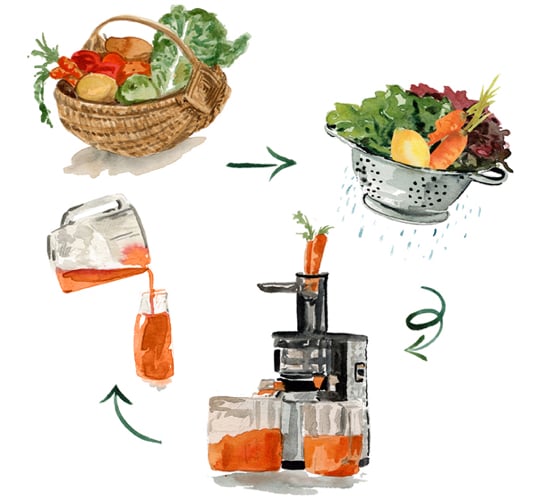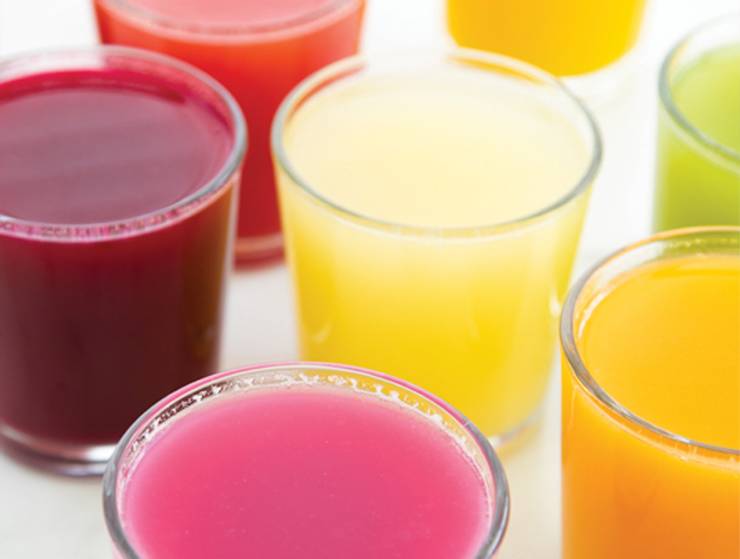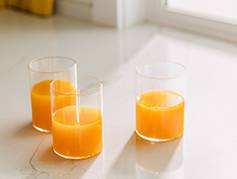Articles
Juicing Series Part 2: Everything You Ever Wanted to Know About Juicing
Get started on your journey with these beginner tips for juicing.
One of the easiest ways to boost nutrients in your diet and have more energy is to make and drink a fresh juice as often as you can. Sometimes the hardest part is just getting started. From choosing the right equipment to selecting healthy yet tempting recipes, here’s what you need to know to get started and go from novice to juice connoisseur quickly.
Why Juice
The biggest reason to juice? It’s an easy, effective way to consume more fruits and vegetables. It’s simple but not always easy as most people struggle to eat enough fresh produce. The latest Dietary Guidelines for Americans, recommend adults should consumer 4.5 cups of fruits and vegetables every day, but 90 percent of us miss the mark.
Here are some of the benefits of taking in plenty of fruits and vegetables, according to the Harvard T.H. Chan School of Public Health:
- lower blood pressure
- reduced risk of several serious diseases, including stroke, heart disease, cancer and potentially type 2 diabetes
- helps with digestion
- can assist in controlling hunger and may lead to weight loss
- supports eye health
If you’re not up for steaming cups of veggies or making big salads each day, making juice is another way to reach your daily goals.
Juicing makes it easy to take in that volume of produce, while also making it easier to absorb the nutrients, since it removes fiber (more on that later).
Get Equipped
Skip the pricey trips to a juice bar and choose the ingredients you like best in your beverage by making your own juice at home. You only need one piece of equipment: a juicer.
Yes, it can be an investment, but it also allows you to get creative with your juices and utilize produce from your local store, farmers’ market or even your own garden. Juicing can be a great way to use up extra veggies or herbs in the fridge before they go bad.
When selecting a juicer, choose the one that works best for you and your family and learn about the different pros and cons of each style.
3 Main Types of Juicers:
- Cold Press/Slow: This juicer has an auger that rotates and presses produce against the strainer to release juice and separate out the pulp. These machines are quiet and easy to use, and can generally make nut milks, smoothies and sorbet.
- Horizontal Twin Gear: These machines crush the produce against the strainer to create juice. They can be pricey and can be a bit more complicated to use. Like cold press juicers, they can make nut milks, smoothies and sorbet.
- Centrifugal: These high-speed juicers use sharp blades to shred fruits and vegetables, separating out the pulp. This type of machine produces less juice than the other options and can cause produce to oxidize. They can be quite loud and are not as good for juicing leafy greens like kale.
As well as the juicer’s mechanism, you’ll want to consider its design (from size to noise level) as well as the clean-up process and its versatility.
How to Juice
When it comes down to it, juicing isn’t all that complicated. Once you have your juicer at the ready, here are the next steps.
1. CHOOSE YOUR PRODUCE
Aside from avocado and bananas, which are best saved for smoothies, you can juice almost every fruit and vegetable. Select your favorites! Each one will offer different health benefits, which is why it’s a good idea to juice the rainbow.
For instance, red produce, like strawberries and beets, typically contains vitamin C and other powerful antioxidants. Adding dark leafy greens to the mix provides vitamins A, C, E and K as well as folate, which is good for your heart, according to the USDA.
Along with opting for in-season produce when possible, you’ll want to follow the 80/20 rule, making juices in a ratio of 80 percent vegetables to 20 percent fruit. That way, you won’t accidentally create sugar bombs that cause your blood sugar to spike, mess with your hunger levels or potentially lead to weight gain.
2. WASH AND PREP YOUR FRUITS AND VEGETABLES
Before putting any produce in the juicer, you’ll want to make sure it’s clean. You can skip produce washes, according to the FDA, and feel free to run veggies under your tap or give them a quick wash in filtered water.
Prep vegetables by removing seeds and pits; if the outer skin is tough (think a cantaloupe or lemon), you’ll remove it.
Then, cut your veg and fruit to fit in your juicer’s feeding chute.
 artwork by thescribblist.com
artwork by thescribblist.com3. FEED PRODUCE INTO THE JUICER
Once you’ve cut the produce to size, place it in the feeding chute. Follow your juicer’s instructions to select the appropriate speed for each fruit and vegetable.
If you have a centrifugal juicer, you can run the pulp back through the machine if it’s still moist, so you can get all the juice out. Otherwise, discard pulp, or save it and use it up by adding the pulp to soups, smoothies, veggie burgers and more recipes.
Tip: In some juicers, you’ll want to place a plastic bag in the pulp basket for faster clean up.
4. DRINK UP!
It’s ideal to drink your juice immediately after it comes out of the juicer. Of course, that’s not always convenient: If you need to, you can store juice in glass, airtight containers that are filled to the brim to avoid oxygen exposure.
Freshly made juice will keep for up to two days in the refrigerator.
Don’t forget to clean your machine after using it. Check your juicer’s instruction manual for more information (and to see if it can safely go in the dishwasher).
More Juicing Q’s Answered
Get insights into common juicing conundrums, along with mistakes to avoid.
What about fiber?
Juicing removes most of the insoluble fiber from fruits and veggies, but the soluble fiber, which is important for lowering glucose levels, remains according to the Mayo Clinic. While fiber is important in your diet, there are benefits to removing it from juice. Namely, it speeds up your body’s ability to absorb nutrients. Just make sure you’re still getting fiber with the food you eat throughout the rest of the day, such as in your morning bowl of oats or in a kale salad with dinner.
How much fruit is too much fruit?
Many times, beginners crave a sweet drink, but to get the most benefit from juicing you want to make your drinks veggie heavy. As mentioned, one rule to follow is the 80/20 rule, especially if you are pre-diabetic or prone to blood sugar crashes. Try adding carrots or celery to a pineapple juice with lemon and ginger. Or juice watermelon with cucumbers and kale.
Aim for more variety.
Each veggie and fruit contains a unique set of vitamins, so be sure to mix up your juice recipes to get a variety of nutrients in your diet, per the Harvard T.H. Chan School of Public Health.
Make it spicy if you like.
Adding herbs and spices to your juice adds a wallop of flavor along with health benefits. Cinnamon, for instance, may help lower glucose, as well as cholesterol and triglyceride levels, according to Memorial Sloan Kettering Cancer Center.
Avoid the “Dirty Dozen.”
Don’t let juicing break your budget. For some, buying all organic produce can add up so aim to eliminate the “dirty dozen,” or the 12 fruits and vegetables that have the most pesticides, according to the Environmental Working Group.
Recommended Recipes
Not sure where to begin? You’ll find tons of juice recipes available online.
Try one of these delicious options.
by: Madelene Burry
Article - January 2022
- Choosing a selection results in a full page refresh.
- Press the space key then arrow keys to make a selection.



